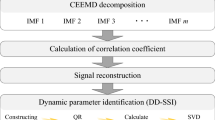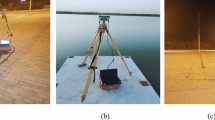Abstract
Global navigation satellite system (GNSS) receivers are commonly utilized for the displacement monitoring of long-span bridges. It is necessary for the structural early warning and identification to accurately extract the trend and dynamic displacement components from the original GNSS displacement signal. In this study, the solution for the component extraction is proposed by an improved variational mode decomposition (VMD) method, which is conducted by the recursive data-driven strategy (hereinafter referred to as RD-VMD). Further, the structural health monitoring (SHM) data of a long-span suspension bridge are used for validation. Firstly, the fourth-order Butterworth low-pass filter (BF) and ensemble empirical mode decomposition (EEMD) are compared to the proposed method for the trend extraction, and the comparison shows that the extraction error by RD-VMD is 1 cm smaller than those by the other two methods from the measured displacement with heavy vehicle passing. Then the measured modes during 168 h identified from the acceleration signals, the GNSS displacement signals, and the dynamic displacement sequences extracted by RD-VMD are compared. Consequently, the extracted dynamic displacement has the highest success rate of modal identification among the three data types. Especially for the second vertical mode, the effective identification results from the dynamic displacement sequences are at least 25% more than those from the other two data types. The statistical results show that the extracted dynamic displacement can be used for automated modal identification. Therefore, the feasibility of the proposed component extraction method is validated by the SHM data.
















Similar content being viewed by others
Data Availability
Some or all data, models, or code generated or used during the study are available from the corresponding author by request.
References
Li X, Ge L, Ambikairajah E, Rizos C, Tamura Y, Yoshida A (2006) Full-scale structural monitoring using an integrated GPS and accelerometer system. GPS Solut 10(4):233–247. https://doi.org/10.1007/s10291-006-0023-y
Nickitopoulou A, Protopsalti K, Stiros S (2006) Monitoring dynamic and quasi-static deformations of large flexible engineering structures with GPS: accuracy, limitations and promises. Eng Struct 28(10):1471–1482. https://doi.org/10.1016/j.engstruct.2006.02.001
Hohensinn R, Häberling S, Geiger A (2020) Dynamic displacements from high-rate GNSS: error modeling and vibration detection. Measurement 80(12):705–719. https://doi.org/10.1016/j.measurement.2020.107655
Moschas F, Stiros S (2011) Measurement of the dynamic displacements and of the modal frequencies of a short-span pedestrian bridge using GPS and an accelerometer. Eng Struct 33(1):10–17. https://doi.org/10.1016/j.engstruct.2010.09.013
Cao H, Qian X, Chen Z, Zhu H (2017) Layout and size optimization of suspension bridges based on coupled modelling approach and enhanced particle swarm optimization. Eng Struct 146(Sept 1):170–183. https://doi.org/10.1016/j.engstruct.2017.05.048
Yi T, Li H, Gu M (2010) Full-scale measurements of dynamic response of suspension bridge subjected to environmental loads using GPS technology. Sci China Ser E 53:469–479. https://doi.org/10.1007/s11431-010-0051-2
Casciati F, Fuggini C (2009) Engineering vibration monitoring by GPS: long duration records. Earthq Eng Eng Vib 8:459–467. https://doi.org/10.1007/s11803-009-9058-8
Yi T, Li H, Gu M (2013) Experimental assessment of high-rate GPS receivers for deformation monitoring of bridge. Measurement 46:420–432. https://doi.org/10.1016/j.measurement.2012.07.018
Chen X (2018) Statistical multipath model comparative analysis of different GNSS orbits in static urban canyon environment. Adv Space Res 62(5):1034–1048. https://doi.org/10.1016/j.asr.2018.06.005
Chen G, Yu L (2021) Analysis of noise characteristics of GNSS-RTK monitoring in various environments. J Navig Posit 9(3):92–97. https://doi.org/10.16547/j.cnki.10-1096.20210315
Xiong C, Niu Y, Wang Z, Yuan L (2019) Dynamic monitoring of a super high-rise structure based on GNSS-RTK technique combining CEEMDAN and wavelet threshold analysis. Eur J Environ Civ En 25:1894–1914. https://doi.org/10.1080/19648189.2019.1608471
Chan W, Xu Y, Ding X, Dai W (2006) An integrated GPS-accelerometer data processing technique for structural deformation monitoring. J Geodesy 80:705–719. https://doi.org/10.1007/s00190-006-0092-2
Xia Q, Zhang J, Tian Y, Zhang Y (2017) Experimental study of thermal effects on a long-span suspension bridge. J Bridge Eng. https://doi.org/10.1061/(ASCE)BE.1943-5592.0001083
Li M, Zhong J, Yan F (2018) Correlation analysis between structure temperature and deflection of a suspension bridge girder. J Vib Shock 37(11):237–245. https://doi.org/10.13465/j.cnki.jvs.2018.11.034
Li Y, Han L, Yi L, Zhong S, Chen C (2021) Feature extraction and improved denoising method for nonlinear and nonstationary high-rate GNSS coseismic displacements applied to earthquake focal mechanism inversion of the El Mayor–Cucapah earthquake. Adv Space Res 68(10):3971–3991. https://doi.org/10.1016/j.asr.2021.07.032
Thong YK, Woolfson MS, Crowe JA, Hayes-Gill BR, Jones DA (2004) Numerical double integration of acceleration measurements in noise. Measurement 36(1):73–92. https://doi.org/10.1016/j.measurement.2004.04.005
Park KT, Kim SH, Park HS, Lee KW (2005) The determination of bridge displacement using measured acceleration. Eng Struct 27(3):371–378. https://doi.org/10.1016/j.engstruct.2004.10.013
Gindy M, Vaccaro R, Nassif H, Velde J (2008) A state-space approach for deriving bridge displacement from acceleration. Comput Aided Civ Inf 23(4):281–290. https://doi.org/10.1111/j.1467-8667.2007.00536.x
Yu J, Meng X, Shao X, Yan B, Yang L (2014) Identification of dynamic displacements and modal frequencies of a medium-span suspension bridge using multimode GNSS processing. Eng Struct 81:432–443. https://doi.org/10.1016/j.engstruct.2014.10.010
Vazquez BGE, Gaxiola CJR, Bennett R, Guzman AGM, Gaxiola CIE (2017) Structural evaluation of dynamic and semi-static displacements of the Juarez Bridge using GPS technology. Measurement 110:146–153. https://doi.org/10.1016/j.measurement.2017.06.026
Chen W, Xiong C, Yu L, Lian S, Ye Z (2021) Dynamic monitoring of an offshore jacket platform based on RTK-GNSS measurement by CF-CEEMDAN method. Appl Ocean Res 115:102844. https://doi.org/10.1016/j.apor.2021.102844
Hu J, Wang L, Song X, Sun Z, Cui J, Huang G (2020) Field monitoring and response characteristics of longitudinal movements of expansion joints in long-span suspension bridges. Measurement 162:107933. https://doi.org/10.1016/j.measurement.2020.107933
Yao X, Yi T, Qu C (2022) Autoregressive spectrum-guided variational mode decomposition for time-varying modal identification under nonstationary conditions. Eng Struct 251:113543. https://doi.org/10.1016/j.engstruct.2021.113543
Rayi VK, Mishra SP, Naik J, Dash PK (2022) Adaptive VMD based optimized deep learning mixed kernel ELM autoencoder for single and multistep wind power forecasting. Energy 244:122585. https://doi.org/10.1016/j.energy.2021.122585
Dragomiretskiy K, Zosso D (2014) Variational mode decomposition. IEEE T Signal Proces 62(3):531–544. https://doi.org/10.1109/TSP.2013.2288675
Bertsekas DP (1982) Constrained optimization and Lagrange multiplier methods. AP
Ni Y, Hua X, Wong K, Ko J (2007) Assessment of bridge expansion joints using long-term displacement and temperature measurement. J Perform Constr Fac 21(2):143–151. https://doi.org/10.1061/(ASCE)0887-3828(2007)21:2(143)
Ni YQ, Wang YW, Zhang C (2020) A Bayesian approach for condition assessment and damage alarm of bridge expansion joints using long-term structural health monitoring data. Eng Struct 212:110520. https://doi.org/10.1016/j.engstruct.2020.110520
Huang H, Yi T, Li H, Liu H (2018) New representative temperature for performance alarming of bridge expansion joints through temperature–displacement relationship. J Bridge Eng 23(7):04018043. https://doi.org/10.1061/(ASCE)BE.1943-5592.0001258
Liu C (2020) Dynamic detection and diagnosis method for beam bridge based on vehicle excited vibration response. Dissertation, Harbin Institute of Technology. https://doi.org/10.27061/d.cnki.ghgdu.2019.005104
Yang YB, Lin CW (2005) Vehicle–bridge interaction dynamics and potential applications. J Sound Vib 284:205–226. https://doi.org/10.1016/j.jsv.2004.06.032
Luo L, Shan D, He M (2021) Adaptive sampling method of suspension-bridge finite element models based on coupled modeling approach. KSCE J Civ Eng 25:3802–3812. https://doi.org/10.1007/s12205-021-1608-2
Liu Y, Zhang S (2017) Probabilistic baseline of finite element model of bridges under environmental temperature changes. Comput Aided Civ Inf 32(7):581–598. https://doi.org/10.1111/mice.12268
Mao J, Wang H, Fu Y, Spencer BF (2019) Automated modal identification using principal component and cluster analysis: application to a long-span cable-stayed bridge. Struct Control Hlth 26(10):e2430. https://doi.org/10.1002/stc.2430
Nie Z, Shen F, Xu D, Li Q (2020) An EMD-SVR model for short-term prediction of ship motion using mirror symmetry and SVR algorithms to eliminate EMD boundary effect. Ocean Eng 217:107927. https://doi.org/10.1016/j.oceaneng.2020.107927
Sun M, Alamdari MM, Kalhori H (2017) Automated operational modal analysis of a cable-stayed bridge. J Bridge Eng 22:05017012. https://doi.org/10.1061/(asce)be.1943-5592.0001141
Pastor M, Binda M, Hararik T (2012) Modal assurance criterion. Proc Eng 48:543–548. https://doi.org/10.1016/j.proeng.2012.09.551
Acknowledgements
This work was supported by the National Natural Science Foundation of China (51978577) and the Science and Technology Project of Power China (No. SCMQ-201728-ZB).
Author information
Authors and Affiliations
Corresponding author
Ethics declarations
Conflict of interest
All authors declare that they have no conflict of interest.
Additional information
Publisher's Note
Springer Nature remains neutral with regard to jurisdictional claims in published maps and institutional affiliations.
Rights and permissions
Springer Nature or its licensor (e.g. a society or other partner) holds exclusive rights to this article under a publishing agreement with the author(s) or other rightsholder(s); author self-archiving of the accepted manuscript version of this article is solely governed by the terms of such publishing agreement and applicable law.
About this article
Cite this article
Luo, L., Shan, D. & Zhang, E. Component extraction method for GNSS displacement signals of long-span bridges. J Civil Struct Health Monit 13, 591–603 (2023). https://doi.org/10.1007/s13349-022-00661-6
Received:
Accepted:
Published:
Issue Date:
DOI: https://doi.org/10.1007/s13349-022-00661-6




